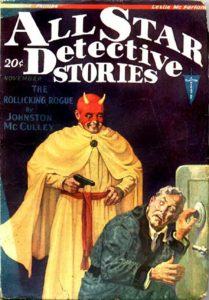 While many may not be familiar with the name Johnston McCulley, we all probably know his most well-known character: Zorro. Zorro started off as a pulp character before moving to serials, movies, comics, and more.
While many may not be familiar with the name Johnston McCulley, we all probably know his most well-known character: Zorro. Zorro started off as a pulp character before moving to serials, movies, comics, and more.
To keep things in context, Zorro was created in 1919, and if you read the first story, it seems clear that McCulley intended him to be a one-off character. When the 1920 movie came out, Zorro became very popular, and it wasn’t until 1922 that he followed up with the second Zorro novella, and the next didn’t appear until 1931!
A few years ago I did this posting on his many other pulp heroes and a few villains, many serialized but a few one-offs. But I didn’t have enough info on several characters and I’ve since learned of more, so this is a revised posting. I feel this article is important because many current pulp fans are not aware of most of McCulley characters outside of Zorro, and his characters used and reused certain themes or tropes and many characters who followed picked many of these up. And there are probably more out there I’m not aware of. So maybe we’ll see another update in a few years?
Now, what are these themes or tropes? Several characters make a point of not killing, and a few of them have gas guns, or use a syringe with a knockout drug. While a few characters have elaborate outfits, some just use a simple full-face mask or hood, sometimes with a mark on it. There is often a “master and man” pairing with the hero being assisted by a loyal servant.
There are also the “vengeance heroes” who are engaged in their activities to carry out revenge against a specific group of people. Sometimes they are called “limited revenge heroes,” as they are focused on a small set of people, and then retire.
And there are the Robin Hood types, who steal from the unjust rich (sometimes for the thrill of it), and give the proceeds to the poor. The vengeance heroes are a type of Robin Hood character. And for all those characters who are thieves of some sort, there is usually a specific cop who is after them and who they often tweak in their civilian identity.
As you look at these characters, you will see a repeat of many of these themes, sometimes with a twist.
If you wish to read these characters, there are a few options. Publishers like Steeger Books (formerly Altus Press), Wildside Press, Ramble House, and Murania Press have put out some collections. But many characters have not been reprinted since Chelsea House (Street & Smith Publications’ book arm) or others did at the time. This happened because most of these characters appeared in S&S’s Detective Story Magazine.
These are some of his other serial characters and their publication dates:
- The Black Star (1916-21, 1928, 1930)
- The Spider (1918-19)
- Thubway Tham (1918-60)
- Madame Madcap (1919)
- Scarlet Scourge (1920)
- The Thunderbolt (1920-21)
- The Demon (1920)
- The Man in Purple (1921)
- The Avenging Twins (1923-26)
- The Crimson Clown (1926-31, 1936, 1944)
- The Rollicking Rogue (1930)
- The Mongoose (1932-33)
- The Whirlwind (1933-35)
- The Green Ghost (1934-35)
- The Bat (1934-35)
Now, some of these I haven’t read (yet), so I can only rely on what others have written. And there may be others that weren’t listed here.
The Black Star is one of the few villains that McCulley wrote, being a “gentleman thief.” He (and his gang) does not kill, using vapor bombs and vapor guns to knock out their victims — and likes to stick black stars everywhere, too. He is opposed by an idle millionaire and his manservant: Roger Verbeck and Mr. Muggs. Verbeck plans to marry his sweetheart once he has defeated The Black Star. The character was popular enough that Chelsea House reprinted some of his stories in hardback. These have been reprinted by Wildside Press, but no one has done a complete reprint of him.
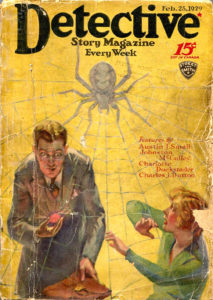 The Spider (not to be confused with Popular Publications’ The Spider) was another villain. He was injured as a youth and confined to a wheelchair, but he uses his intellect to be a criminal mastermind, which he had done previously in Europe. While there is no main opponent in this series, the main character (the “master and man” trope) is an idle former millionaire forced to work for The Spider (due to now being broke), who usually had to thwart other criminals. This main character would fall in love with The Spider’s niece. The Spider, too, had some stories reprinted in hardback, which both Wildside Press and Murania Press have reprinted.
The Spider (not to be confused with Popular Publications’ The Spider) was another villain. He was injured as a youth and confined to a wheelchair, but he uses his intellect to be a criminal mastermind, which he had done previously in Europe. While there is no main opponent in this series, the main character (the “master and man” trope) is an idle former millionaire forced to work for The Spider (due to now being broke), who usually had to thwart other criminals. This main character would fall in love with The Spider’s niece. The Spider, too, had some stories reprinted in hardback, which both Wildside Press and Murania Press have reprinted.
Thubway Tham (actually, the character is “Subway Sam,” but has a lisp and it comes out that way) was popular enough that McCulley was still writing stories (almost 150) about him into the ’50s! He’s a pickpocket who only works the New York Subways, and who only robs from those who deserve it. The appeal of these stories is apparently the humor. For those who speak of meetings or team-ups of pulp characters, Thubway Tham was one of the few who really did it! There is a serial where he meets McCulley’s The Crimsom Clown. And he had meet-ups with characters by other authors: Christopher Booth‘s Mr. Clackworthy and Roy Hinds‘ Simon Trapp. Wildside Press has reprinted two of the original collections of his stories.
Madame Madcap, a one-off character who appeared under McCulley’s “Harrington Strong” pseudonym and serialized in DSM in September-October 1919. This may be the first of his “vengeance heroes.” When an elderly gentleman thief is betrayed by his men and goes to jail, his twin children decide to seek revenge against them, creating a costumed persona: “Madame Madcap.” The difference is they are twin girls, so this is one of the very few and maybe the first female pulp heroine. They also have a hulking black manservant, so there’s also the “master and man” trope — the difference is the master is female! Maybe this is an early inspiration for the Domino Lady? This not the last time that McCulley had a strong female lead in his detective stories.
The Scarlet Scourge, another one-off character under the Harrington Strong pseudonym, again from DSM, introduces an array of characters working with several businesses in a building. We have two crooked brokers who have a falling out. They have swindled several people, including some of the people in the story. Then a mysterious character called “The Scarlet Scourge” threatens to expose the brokers. Then one of them is killed. Is the Scourge responsible? Who is the Scourge, and why go after the brokers? In the end, all is revealed, and it’s surprising who the Scourge is. This has been reprinted by Wildside Press from a Chelsea House edition.
The Thunderbolt is another of the “limited vengeance” hero, usually put forth as McCulley’s first. He’s a rich man who is also aided by a servant. When well-off bachelor John Flatchley finds out that the money left him by his uncle, his last living relative, is tainted, he returns the money to its rightful owners. And decides to go after the six financiers who were behind it all, to ensure all the stolen money is returned, then retire and marry his love. His disguise is a tight black hood with a lightning bolt on it. He is aided by his new valet, Saggs, who he meets in the first story. And he is opposed by Detective Radner, who knows Flatchley and suspects him, but hasn’t been able to catch him. Later reprinted in two Chelsea House volumes, only the first has been reprinted in modern times.
The Demon, yet another one-off character, also appeared as by “Harrington Strong.” Someone calling themselves The Demon, while wearing a tight full-face mask with horns, is beating up criminals to get them to go straight. A crooked alderman is killed, and there’s a crooked cop, as well as a good cop. Who is The Demon, and what does he want? You’ll have to read it to find out. For once, we don’t get a vengeance hero, no “master and man,” or even a Robin Hood-type. Chelsea House put it out in book form, and Wildside Press has reprinted that.
The Man in Purple is another interesting, if short-lived, character. Steeger Books has reprinted the series. The MiP is really well-off man-about-town Richard Staegel. He’s handsome and young and athletic, and engaged to Betty Hayler. But they both want thrills before marrying and settling down, so decide to go into crime and steal from the rich, but only the rich who have gotten their wealth by ripping off “widows and orphans,” and all their take is given to charity. Another Robin Hood trope. The MiP persona is created, which is Richard dressed in an all purple outfit, including a full-face mask. To prevent any connection, Richard uses special material that is easily destroyed, leaving no evidence. Assisting them is Broph, a down-and-out guy Richard rescues and recruits in the first story, giving us the “master and man” element. Opposing them is Detective Troman.
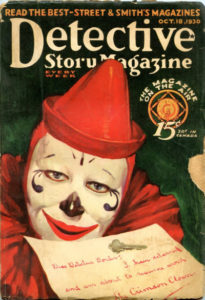 The Avenging Twins is another version of the “limited revenge” hero, similar to The Thunderbolt. Instead of one man, it’s twin brothers who set out to punish six rich men who ruined the uncle who raised them, leading to his death. There is no mask, but they use the fact that they are twins to give each other alibis. Added to this is a third person, a girl who is helping them, somewhat similar to The Grey Seal‘s Tocsin. After six stories, the series was over, though they would come back for two more stories. Chelsea reprinted the first six stories into two books, but only the second has been reprinted.
The Avenging Twins is another version of the “limited revenge” hero, similar to The Thunderbolt. Instead of one man, it’s twin brothers who set out to punish six rich men who ruined the uncle who raised them, leading to his death. There is no mask, but they use the fact that they are twins to give each other alibis. Added to this is a third person, a girl who is helping them, somewhat similar to The Grey Seal‘s Tocsin. After six stories, the series was over, though they would come back for two more stories. Chelsea reprinted the first six stories into two books, but only the second has been reprinted.
The Crimson Clown was another popular character, and is similar to The Man in Purple. He is also a rich man-about-town, Delton Prouse, who uses the persona of The Crimson Clown to steal from the unjust rich and return the money to their victims (yup, another Robin Hood type). He uses a syringe of knockout drug, and later a gas gun (picked up from The Black Star and used by some others). There is no servant to help him (or girlfriend/fiance), but he must contend with Detective Donler who is after the Clown, so often Prouse must make it appear as he’s run afoul of the Clown to get away. His colorful outfit, like the Man in Purple’s, is destroyed with acid to cover his tracks. Chelsea House did two collections of stories, and Ramble House has reprinted them. But many have not been reprinted. Bold Venture reprinted the serial that has the Clown meet Thubway Tham.
The Rollicking Rogue was a very short-lived character, appearing in all of two stories. Steeger Books included him in their Green Ghost collection. The Rollicking Rogue is more in the vein of Zorro, with his alter ego being timid James Peters (probably not his real name). He’s another “revenge hero,” but with a slight difference. His father was ruined by a group 10 years prior, and both parents are now dead, but we don’t know how many are in the group. His main foe is Detective Martin Shane, who works for his victims. When the Rogue goes into action, he dresses in a colorful and outlandish outfit. This is seen in all its glory on the cover of his first appearance in All-Star Detective Stories (November 1930).
The Mongoose is another variation on the vengeance hero. Here he goes after crooks who drove his father to death. A difference is he’s joined by his sister, who works her way into the crooks organization, setting things up for The Mongoose to strike. It’s not clear how many they will need to go after, and the series ended after nine stories without a clear resolution. Unlike most of the prior works, this series appeared in Munsey’s Detective Fiction Weekly. Steeger Books has recently reprinted this in their Argosy Library line.
At this point, the editor McCulley worked with at Detective Story Magazine left, so he wound up working with Thrilling. I suspect that The Mongoose was planned for DSM, but he took it to DFW instead.
The Whirlwind was a short-lived Zorro-like character. Steeger Books reprinted the whole series. The Whirlwind is really a nameless Spanish noble who has left Spain (and his family wealth) over an argument with his father (what about is never given). He arrives in a small village and takes a new name and works for the local innkeeper. He tames the innkeeper’s horse in secret, and uses him in his escapades, which is to rob mean-hearted merchants and give to the poor. His main opponent is the local sergeant. The innkeeper’s daughter seems to know who he really is, as does the local friar. But the number of characters are kept few, due to the shortness of the stories. Many of the rest of the stories deal more with other villains who are clearly evil, sometimes murdering others (something which The Whirlwind does not do) and committing crimes The Whirlwind is blamed for. The Whirlwind is motivated by thrills, rather than a sense of justice (as with Zorro).
The Green Ghost (not to be confused with the later Green Ghost by G.T. Fleming-Roberts) is another short-lived character. Steeger Books has reprinted the whole series. This Green Ghost ran for seven stories in 1934-35 in Thrilling Detective magazine. Former cop Danny Blaney puts on a green hood and gloves to fight crooks. We learn in the first story that Blaney was framed by crooks and lost his job as a cop. Though he fights crooks, he isn’t much for cops either, because they think he’s dirty. But clearing his name doesn’t seem to be part of the plot, so he’s not much of a “revenge hero” as others, and only in a few stories does he target those crooks who framed him. Each story is pretty short and enjoyable. There are almost no secondary characters, we see nothing of his personal life, and don’t see much of the tobacco store he owns except at the end of stories when he drops by. Otherwise, the stories are pretty much The Green Ghost going into action.
The Bat was another short-lived character in the model of McCulley’s other characters, wearing a sack-cloth mask with a white bat on the forehead, and the theme of an innocent man framed who strikes back at his enemies — another “vengeance hero” who uses a gas gun. Like Popular Publications’ The Spider (not the McCulley one), The Bat has a special ink stamp that he stamps on the forehead of the criminals he catches (but doesn’t kill), at least in the first story. Sadly, this is another series that wasn’t resolved. The whole series was collected by Steeger Books.
So hopefully after this people have a better appreciation of the works of Johnston McCulley. In reading these characters I saw many elements that appear in later pulp heroes. Among these are Alias Mr. Death, The Moon Man, The Spider, and The Black Bat. And there may be more that I’m not aware of.

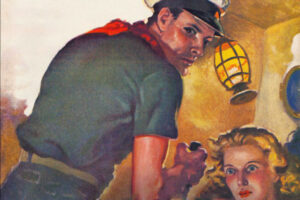
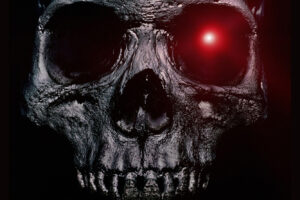
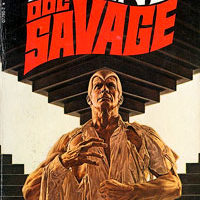
[…] Fiction (Pulp Net): While many may not be familiar with the name Johnson McCulley, we all probably know his most […]
[…] Fiction (Pulp Net): While many may not be familiar with the name Johnson McCulley, we all probably know his most […]